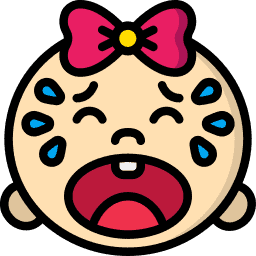Has a white rash appeared in your baby’s mouth? Have you noticed increased pain and skin changes around your nipples?
If so, you or your baby may be suffering from thrush.
While this infection can be unpleasant, it’s not a severe illness and shouldn’t have any long-lasting effect on you or your baby.
In this article, we’ll discuss how to prevent and treat thrush while breastfeeding.
Key Takeaways
- Thrush is a fungal infection caused by an overgrowth of Candida fungus, affecting babies’ mouths and mothers’ nipples during breastfeeding.
- Common symptoms include a white oral rash in babies, red cracked mouths, and flaky, shiny nipples with increased pain in mothers.
- Preventing thrush involves keeping breasts dry and cool, maintaining cleanliness, washing hands regularly, and consuming yogurt or probiotics.
- Treatments include prescribed antifungal creams like Nystatin and at-home remedies such as reducing sugar intake, using coconut oil, and trying gentian violet (with a doctor’s approval).
- What is Thrush?
- What Are The Symptoms of Thrush?
- What Causes Thrush?
- Antibiotics, Breast Milk, and Thrush
- Can Thrush Be Transferred?
- Do I Need to Stop Breastfeeding?
- Can I Scrape Thrush Off?
- How Can I Prevent Thrush While Breastfeeding?
- How Can I Treat Thrush?
- At-Home Relief of Thrush
- Products for Treating Thrush
- FAQs
What is Thrush?
Medically known as oral candidiasis, thrush specifically refers to a fungal infection of the mouth. Thrush can also affect a woman’s nipples during breastfeeding.
Take Note
Candida fungus is essential to our health, working with different types of gut bacteria as part of a healthy digestive system. However, the overproduction of Candida often leads to infection in people of all ages (1).
Thrush is common, affecting 1 in 20 babies, and is generally easy to treat.
However, it can be a symptom of underlying medical issues. If you or your baby get thrush consistently, especially after you’ve stopped breastfeeding, talk to your doctor.
What Are The Symptoms of Thrush?
Thrush has some very recognizable symptoms in both babies and mothers.
Here are a few you should be on the lookout for (2):
- A white, puffy oral rash: Often appears on the tongue and inside of the cheeks and has a creamy, cottage-cheese-like appearance.
- A red, cracked mouth: Your baby may also struggle to feed and become fussy during breastfeeding.
- Changes in your nipples: Mothers battling thrush may find their nipples become flaky and shiny with increased pain and sensitivity.
- Vaginal yeast infections: Mothers with thrush commonly experience vaginal yeast infections as well.
- Look for diaper rashes: Babies with thrush may have more pronounced diaper rashes.
Doctors can generally diagnose thrush based on appearance alone. However, your doctor may swab the area to take a closer look.
If you have a rash and you aren’t sure if it’s thrush, don’t hesitate to pay a visit to the doctor.
What Causes Thrush?
The extended use of antibiotics is the most common cause of the bacterial imbalance that can lead to thrush is the extended use of antibiotics (3).
Antibiotics combat dangerous or illness-causing bacteria. However, they can also eliminate beneficial bacteria that keep your body in balance.
Without the necessary bacterial balance, Candida can grow rapidly. In other cases, babies are exposed to yeast in the birth canal, which can linger and develop into thrush.
Take Note
Antibiotics, Breast Milk, and Thrush
Some antibiotics enter your bloodstream and eventually transfer to your breast milk. So even if you’re the one taking antibiotics, your breastfeeding baby’s healthy gut bacteria levels can be affected. Newborns and babies under six months old are most at risk.
While most medications you take will have a minimal effect on your baby while breastfeeding, you should always discuss any new medications, including birth control, with your doctor.
Can Thrush Be Transferred?
One of the peskiest things about thrush is the possible transference from mother to child, or vice versa.
If you have a thrush infection and your baby is nursing, their mouth is exposed to the bacteria. When a baby with thrush latches onto your nipple, the bacteria can be transferred to your sensitive breast skin. In fact, when a mom or baby has thrush, other family members may even get it.
Do I Need to Stop Breastfeeding?
If either you or your baby has thrush, it’s important for you to both be treated, even if one of you does not have symptoms. It is not necessary to stop breastfeeding during treatment.
You may wonder if pumping your breast milk may help during this period. This is not recommended since you could contaminate your pump parts and bottles with the Candida or transfer it to your baby through the pumped milk.
You can feed your baby fresh or frozen breast milk while you are both being actively treated, but you should not store milk you have pumped during a bout of thrush . Freezing will deactivate yeast but not kill it (5).
Editor's Note:
Michelle Roth, BA, IBCLCCan I Scrape Thrush Off?
When you notice a white substance in your baby’s mouth, your first instinct may be to wipe it away. After all, babies often have milk stains in their mouths and on their faces. If you can easily get it off, it’s not thrush.
If it doesn’t come away easily, don’t try to scrape out your baby’s mouth as this can expose tender, bleeding skin and cause a greater risk for other infections.
How Can I Prevent Thrush While Breastfeeding?
These are some of the many ways to prevent bacteria from growing out of control and causing a thrush infection.
1. Keep Your Breasts Dry and Cool
Yeast likes to grow in dark, warm places, and Candida is no exception.
Prevent thrush by making sure your breasts remain cool and dry:
- Avoid tight clothing made of synthetic fabrics.
- Choose nursing pads made of natural fabrics. Plastic liners and rubbery fabrics can trap heat and irritate the skin.
- Change your breast pads often. If you wear moist breast pads too long, bacteria and fungi can grow in the warm, damp environment.
- Moisturize your breasts sparingly. If you do, make sure the moisturizer absorbs well, and don’t put your bra or clothes on before your skin is dry.
2. Keep Things Clean
You can also prevent thrush by keeping everyday objects clean and free of harmful bacteria and fungi. You should regularly sanitze and thoroughly dry baby toys, breast pumps, pacifiers, and other objects you and your baby touch.
Quick Tip
3. Wash Your Hands
As we all know, hand washing is one of the most effective ways to prevent infections from spreading.
To help prevent thrush, scrub your hands with old fashioned hand soap and water regularly—and encourage everyone in your home to do the same. It’s especially important to wash your hands after diaper changes. When you’re on the go, hand sanitizer is an easy option.
4. Indulge in Some Yogurt
Yogurt is full of good bacteria and probiotics your digestive system needs. Filled with live bacterial cultures, it’s a delicious way to ensure body balance and gut health.
Check the label for Lactobacillus, which is key in regulating your microbiome. Choose plain yogurt as the flavored varieties contain more sugar, which is yeast’s favorite food! Try to eat a serving every day to help your body keep bacteria in check.
Non-Dairy Tip
How Can I Treat Thrush?
If you or your baby are suffering from thrush, contact your doctor for an official diagnosis. Your doctor may prescribe something like Nystatin, an antifungal cream that’s applied orally or topically.
Even if you aren’t showing symptoms of thrush, it’s a good idea for you and your baby to be treated as a preventative measure. Candida can incubate for five days or longer without symptoms (6).
For most moms and babies, thrush will generally clear up within two weeks of beginning treatment. Continue to use your prescribed medicine, even if the infection disappears. If you don’t, the infection may linger and reappear.
Take Note
At-Home Relief of Thrush
In addition to medicine prescribed by your doctor, there are a few things you can do at home to find some relief from thrush.
- Reduce sugar intake: Sugar helps yeast grow, and a diet high in sugar can make thrush symptoms worse. Focus on foods high in vitamins and protein.
- Use coconut oil: Cocounut oil soothes your cracked nipples while providing natural antifungal properties. You can rub a little bit of coconut oil inside your baby’s mouth, but make sure they do not swallow it.
- Go topless: Go to bed bare, exposing your breasts to fresh, free-flowing air. Yeast thrives in moist, damp environments.
- Try gentian violet: This antiseptic dye will turn anything it touches dark purple, but it’s an old-school effective method for clearing up thrush (7). Swab the formula on the affected area with cotton and allow it to dry. Speak with your doctor before trying this method — especially before using it in your baby’s mouth.
Products for Treating Thrush
Throughout this post, we’ve mentioned a few ways to help you prevent and treat thrush.
There are many items out on the market to help you through this time. You can find them online or through your local baby store.
- Nursing Pads for Thrush: The right breast pads can prevent your breasts from becoming a breeding ground for Candida yeast.
- Breast Therapy for Thrush: Gel packs and heat therapy pads may bring you some relief if your nipples and breasts are in pain due to thrush.
- Creams for Thrush: Nipple creams and lotions can provide relief for moms with cracked, sore nipples due to thrush.
- Baby Probiotics: Probiotics can help restore healthy bacteria levels. While it’s easy for mama to get her fix with some yogurt, a baby may have a harder time with their sensitive stomach.










